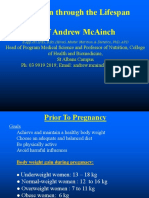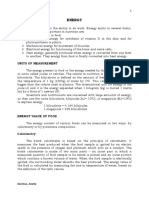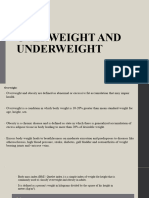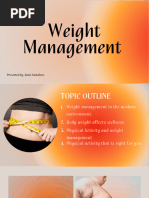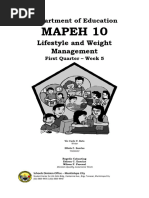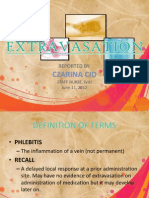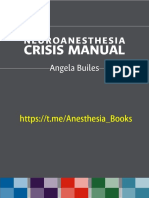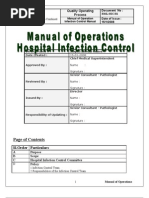Energy Balance PPT 1114he2
Energy Balance PPT 1114he2
Uploaded by
Inthira SanmugamCopyright:
Available Formats
Energy Balance PPT 1114he2
Energy Balance PPT 1114he2
Uploaded by
Inthira SanmugamOriginal Title
Copyright
Available Formats
Share this document
Did you find this document useful?
Is this content inappropriate?
Copyright:
Available Formats
Energy Balance PPT 1114he2
Energy Balance PPT 1114he2
Uploaded by
Inthira SanmugamCopyright:
Available Formats
Energy balance
www.foodafactoflife.org.uk © Food – a fact of life 2019
Energy balance
To maintain body weight it is necessary to balance energy intake (from
food and drink) with energy expenditure (from activity).
This is called energy balance.
When energy intake is higher than energy output, over time this will lead
to weight gain (positive energy balance).
When energy intake is lower than energy output, over time this will lead
to weight loss (negative energy balance).
www.foodafactoflife.org.uk © Food – a fact of life 2019
Positive energy balance
A person is said to be in positive energy balance when the diet provides
more energy than is needed to meet energy demands of the body. Energy is
stored as fat and the person puts on weight over time.
People who achieve a positive energy balance over an extended period of
time are likely to become overweight or obese.
Being overweight or obese is associated with an increased risk of
developing certain cancers, cardiovascular disease and type 2 diabetes. Energy out:
activity
Carrying a large amount of weight/fat around the waist also increases the
risk of these health problems.
Energy in:
food and
drinks
Energy in > Energy out = Weight gain
www.foodafactoflife.org.uk © Food – a fact of life 2019
Negative energy balance
A person is said to be in negative energy balance when there is insufficient energy from the diet
to meet energy demands of the body. Energy is derived from energy stores and the person
loses weight.
People who achieve a negative energy balance over an extended period of time are likely to
become underweight.
Being underweight is associated with health problems, such as osteoporosis (low bone mass),
infertility (difficulty to conceive) and even heart failure.
Energy in:
food and
drinks
Energy out:
activity
Energy out > Energy in = Weight loss
www.foodafactoflife.org.uk © Food – a fact of life 2019
Energy balance
Energy balance can be maintained by:
• regulating energy intake through the diet;
• adjusting physical activity levels;
• a combination of both.
www.foodafactoflife.org.uk © Food – a fact of life 2019
Energy balance
In the UK and many other developed countries, overweight
and obesity rates in adults and children have been
increasing over the years.
According to Statistics on Obesity, Physical Activity and Diet
published in 2018, 57% of adult women and 66% of adult
men are overweight or obese.
It is important to lead an active lifestyle and make healthier
food choices.
www.foodafactoflife.org.uk © Food – a fact of life 2019
Physical activity
Physical activity should be an important part of our daily energy
expenditure.
Many different types of activity contribute to our total physical
activity, all of which form part of everyday life.
What do you think physical activity includes?
• Activity at work, e.g. use the stairs not the lift.
• Household chores, e.g. vacuuming.
• Looking after others.
• Leisure-time activities, e.g. gardening.
• Transport (walking or cycling to school or work).
www.foodafactoflife.org.uk © Food – a fact of life 2019
• Sport.
Physical activity
Children and young people are recommended to do
at least 60 minutes of moderate intensity exercise
every day.
Adults are recommended to do at least 150 minutes
of moderate aerobic activity every week or 75
minutes of vigorous aerobic activity. They are also
recommended to do strength exercises on two or
more days a week that work all the major muscles.
www.foodafactoflife.org.uk © Food – a fact of life 2019
Physical activity
Average physical activity levels in the UK are lower
than recommendations. Most adults, older children
and teenagers do not meet the targets.
According to Statistics on Obesity, Physical Activity
and Diet published in 2018, only 23% of boys and
20% girls meet the physical activity guidelines and
21% of adult men, and 25% of adult women are
classified as inactive (they do fewer than 30 minutes
physical activity a week).
Source: NHS Digital
www.foodafactoflife.org.uk © Food – a fact of life 2019
Energy balance
For further information, go to:
www.foodafactoflife.org.uk
www.foodafactoflife.org.uk © Food – a fact of life 2019
You might also like
- Speech and Hearing Science-Anotomy and Physiology ZemlinDocument622 pagesSpeech and Hearing Science-Anotomy and Physiology ZemlinelkkrotNo ratings yet
- The Nature Fix - Why Nature Makes Us Happier, Healthier and More Creative PDFDocument287 pagesThe Nature Fix - Why Nature Makes Us Happier, Healthier and More Creative PDFJohann Frederic Pluftree100% (11)
- Nursing Care Plan For CholedocholithiasisDocument2 pagesNursing Care Plan For Choledocholithiasis_cezca_100% (3)
- ANA Profile 3Document20 pagesANA Profile 3vemalNo ratings yet
- Obesity PPT 1416heDocument11 pagesObesity PPT 1416heMeity ElvinaNo ratings yet
- ObesityDocument11 pagesObesityEssam MehannaNo ratings yet
- Food and EneryDocument31 pagesFood and EneryShrimoyeeNo ratings yet
- 1586880748unit 12 Weight Control Management PDFDocument13 pages1586880748unit 12 Weight Control Management PDFkrishmasethiNo ratings yet
- Defining Overweight and ObesityDocument22 pagesDefining Overweight and ObesityDr Nurul NabilahNo ratings yet
- Lifestyle and Weight Management-UpdatedDocument20 pagesLifestyle and Weight Management-UpdatedJona DiezNo ratings yet
- Module ThreeDocument24 pagesModule ThreeMustafe Nouh Ma�alin QasimNo ratings yet
- Nutrition Through The Lifespan and Diet and Disease BackupDocument67 pagesNutrition Through The Lifespan and Diet and Disease BackupJessica SnowNo ratings yet
- Health Weight Management 1Document11 pagesHealth Weight Management 1DragoșNo ratings yet
- Lifestyle and Weight Management Pe9Document39 pagesLifestyle and Weight Management Pe9Bea Valerie GrislerNo ratings yet
- Cagayan State UniversityDocument5 pagesCagayan State UniversityLovely Joy Benavidez BarlaanNo ratings yet
- A.N Unit 03Document26 pagesA.N Unit 03Hira KhanNo ratings yet
- Introd. To NutritionDocument11 pagesIntrod. To NutritionBenjamin KipandaNo ratings yet
- Art & Sci of Wt. Mgmt.Document61 pagesArt & Sci of Wt. Mgmt.Ashlesha MishraNo ratings yet
- Lesson 5. Health and NutritionDocument5 pagesLesson 5. Health and NutritionLoveyysolonNo ratings yet
- Nline Eight Management Ounseling Program For Ealthcare ProvidersDocument49 pagesNline Eight Management Ounseling Program For Ealthcare ProvidershermestriNo ratings yet
- DIET-DURING-YOUNG-AND-MIDDLE-ADULTHOOD (New)Document18 pagesDIET-DURING-YOUNG-AND-MIDDLE-ADULTHOOD (New)coosa liquorsNo ratings yet
- Ingles ObesiyDocument4 pagesIngles ObesiyBryan Andrés AnguloNo ratings yet
- I Want To Lose Weight - Which Diet Is Best Jama 2021Document1 pageI Want To Lose Weight - Which Diet Is Best Jama 2021Hugo Whysk LeonardoNo ratings yet
- Nutrition For Health and FitnessDocument36 pagesNutrition For Health and FitnessFaatoots FatsNo ratings yet
- Genes: Obesity May Be Passed Down Through Families.: Obesity - A National EpidemicDocument2 pagesGenes: Obesity May Be Passed Down Through Families.: Obesity - A National EpidemicShinnn 123No ratings yet
- Lecture 10 NutritionDocument12 pagesLecture 10 Nutritionnayxaa6 salatunNo ratings yet
- What Are Obesity and Overweight?Document27 pagesWhat Are Obesity and Overweight?Raju SNo ratings yet
- ( ( ( . NUTRITION in BALANCED Diet ..) ) )Document2 pages( ( ( . NUTRITION in BALANCED Diet ..) ) )ZEE zeeNo ratings yet
- Weightt ManagementDocument6 pagesWeightt Managementapi-3773207No ratings yet
- Obesity: DefinitionDocument4 pagesObesity: DefinitionfynneroNo ratings yet
- EnergyDocument6 pagesEnergygaurav sharmaNo ratings yet
- To Lose Weight The Wrong Way Is A Health FactorDocument12 pagesTo Lose Weight The Wrong Way Is A Health FactorBernard EasterlingNo ratings yet
- 105Document12 pages105johncarlo ramosNo ratings yet
- Fueling Greatness (Your Ultimate Nutrition Blueprint)Document29 pagesFueling Greatness (Your Ultimate Nutrition Blueprint)zivsantosNo ratings yet
- PEH 2 - Lesson 2-Energy Intake, Expenditure and BalanceDocument22 pagesPEH 2 - Lesson 2-Energy Intake, Expenditure and BalanceHeron LacanlaleNo ratings yet
- Quantas Calorias Devo Comer Por DiaDocument11 pagesQuantas Calorias Devo Comer Por DiaSheilani MartinsNo ratings yet
- Unit-3 ADocument51 pagesUnit-3 Aanjalidhanala45No ratings yet
- Health PsychologyDocument12 pagesHealth PsychologywaqarkhankhambaNo ratings yet
- 1st Quarter ReadingsDocument9 pages1st Quarter ReadingsJamilah Anne A. MacasimbarNo ratings yet
- PE 2 Weight Management PresentationDocument25 pagesPE 2 Weight Management PresentationButter CupsNo ratings yet
- Module 2 Lesson 4Document13 pagesModule 2 Lesson 4Roger DarvinNo ratings yet
- SLEM PE 10 WEEK 5 Q 1 FINALddddddDocument14 pagesSLEM PE 10 WEEK 5 Q 1 FINALddddddstrangekittie50No ratings yet
- American Cancer Society Guidelines On Nutrition and Physical Activity For Cancer PreventionDocument30 pagesAmerican Cancer Society Guidelines On Nutrition and Physical Activity For Cancer PreventionAshraf DalumaNo ratings yet
- Diet & Health BiDocument12 pagesDiet & Health Bikiran shehzadiNo ratings yet
- Food and Nutrition Issues and Challanges of CommonDocument24 pagesFood and Nutrition Issues and Challanges of CommonGourav AggarwalNo ratings yet
- Weight: The of Your HealthDocument7 pagesWeight: The of Your HealtharythaNo ratings yet
- Understanding Obesity: A New Hope For Weight Loss and Escaping Food AddictionFrom EverandUnderstanding Obesity: A New Hope For Weight Loss and Escaping Food AddictionRating: 1 out of 5 stars1/5 (1)
- Lifestyle and Weight Management Pe 9 Jun4 2019Document41 pagesLifestyle and Weight Management Pe 9 Jun4 2019johann reyesNo ratings yet
- Introduction To Nutrition: Nutrition Food Substances Essential Nutrients Daily Energy UseDocument12 pagesIntroduction To Nutrition: Nutrition Food Substances Essential Nutrients Daily Energy UseDajana RakićNo ratings yet
- Week 17 - AppetiteDocument4 pagesWeek 17 - AppetiteRhea RaichuraNo ratings yet
- Lifestyle and Weight ManagementDocument19 pagesLifestyle and Weight ManagementAltheaMarie MarquezNo ratings yet
- Dietary Management in UnderweightDocument12 pagesDietary Management in UnderweightFakeNo ratings yet
- 1719219642_22_Class_12_PE_ch_5Document4 pages1719219642_22_Class_12_PE_ch_5sjaaiaywwywwNo ratings yet
- Document 1Document3 pagesDocument 1fatimaNo ratings yet
- Dancing Is More Than Just Moving Body Parts It Is A Pathway of Expressing Your Deepest Inner Thoughts.Document5 pagesDancing Is More Than Just Moving Body Parts It Is A Pathway of Expressing Your Deepest Inner Thoughts.Miss HeartNo ratings yet
- Level 4 Comprehension 1 Exercise VS DietDocument2 pagesLevel 4 Comprehension 1 Exercise VS DietWong YanNo ratings yet
- Lean Belly Nutrition And Dieting: Weight Loss And Lean Belly Dieting StrategiesFrom EverandLean Belly Nutrition And Dieting: Weight Loss And Lean Belly Dieting StrategiesNo ratings yet
- Nutrition Therapy For Obesity and Weight Control and DMDocument11 pagesNutrition Therapy For Obesity and Weight Control and DMparkjongseong9914No ratings yet
- 11 - Balanced Diet and Energy BudgetDocument30 pages11 - Balanced Diet and Energy BudgetSiti Raihan Py AzahariNo ratings yet
- Laura Oré Chiara: Overweight and ObesityDocument24 pagesLaura Oré Chiara: Overweight and ObesityLaura OréNo ratings yet
- World Obesity Day 2024Document25 pagesWorld Obesity Day 2024Fatema AlburiNo ratings yet
- Presentation Package For Concepts of Physical Fitness 14e: Managing Diet and Activity For Healthy Body FatnessDocument55 pagesPresentation Package For Concepts of Physical Fitness 14e: Managing Diet and Activity For Healthy Body FatnesspeerboyNo ratings yet
- General Physical Examination: DR Preamala.G Medical Department HTJ, SerembanDocument54 pagesGeneral Physical Examination: DR Preamala.G Medical Department HTJ, SerembanInthira SanmugamNo ratings yet
- Sport InjuriesDocument23 pagesSport InjuriesInthira SanmugamNo ratings yet
- 1716607306Document54 pages1716607306Inthira SanmugamNo ratings yet
- MCQDocument9 pagesMCQInthira SanmugamNo ratings yet
- HydrotherapyDocument30 pagesHydrotherapyInthira SanmugamNo ratings yet
- Sun Salutation PracticeDocument26 pagesSun Salutation PracticeInthira Sanmugam100% (1)
- Mpu 2163 Penulisan Group 2Document20 pagesMpu 2163 Penulisan Group 2Inthira SanmugamNo ratings yet
- Nabihah (High)Document17 pagesNabihah (High)Inthira SanmugamNo ratings yet
- Topic 1. Evolution of Human LifeDocument53 pagesTopic 1. Evolution of Human LifeInthira SanmugamNo ratings yet
- 3.oxidative Stress and Restoring BalanceDocument13 pages3.oxidative Stress and Restoring BalanceInthira SanmugamNo ratings yet
- An Alternative Solution For A Complex Prosthodontic Problem: A Modified Andrews Fixed Dental ProsthesisDocument5 pagesAn Alternative Solution For A Complex Prosthodontic Problem: A Modified Andrews Fixed Dental ProsthesisDragos CiongaruNo ratings yet
- GNM 2nd Year PaperDocument11 pagesGNM 2nd Year PaperJitendra bhargav bhargavNo ratings yet
- Seri Final NotesDocument179 pagesSeri Final Notesbharath gowdaNo ratings yet
- Seed Dormancy: Presented by Payushni Bhuyan Roll No-S1700803Document27 pagesSeed Dormancy: Presented by Payushni Bhuyan Roll No-S1700803Payushni BhuyanNo ratings yet
- What We Know About Effects of Sport and Elite Athletics On Child Development OutcomesDocument82 pagesWhat We Know About Effects of Sport and Elite Athletics On Child Development Outcomesandreea_zgrNo ratings yet
- EXTRAVASATIONDocument19 pagesEXTRAVASATIONphp_czarina04421No ratings yet
- MORTALITY AUDIT FORM FOR HIV - TB - HEI CLIENTS Final VersionDocument12 pagesMORTALITY AUDIT FORM FOR HIV - TB - HEI CLIENTS Final VersionMigori ArtNo ratings yet
- Neuroanesthesia Crisis ManualDocument56 pagesNeuroanesthesia Crisis ManualChrismas BangunNo ratings yet
- Bloat in Ruminants: Robert W. DoughertyDocument6 pagesBloat in Ruminants: Robert W. DoughertyPankaj PathakNo ratings yet
- Quiz on Human Skeletal System - ProProfs QuizDocument6 pagesQuiz on Human Skeletal System - ProProfs Quizdharmaraj.essbeeNo ratings yet
- Antimicrobial StewardshipDocument7 pagesAntimicrobial StewardshipMehwish MughalNo ratings yet
- Endometrial CancerDocument192 pagesEndometrial CancerAbhishek VijayakumarNo ratings yet
- (Clinical Chemistry and Laboratory Medicine (CCLM) ) Implementation of Standardization in Clinical Practice Not Always An Easy TaskDocument5 pages(Clinical Chemistry and Laboratory Medicine (CCLM) ) Implementation of Standardization in Clinical Practice Not Always An Easy TaskJulián Mesa SierraNo ratings yet
- Reflexology New Patient FormDocument7 pagesReflexology New Patient FormOana Iftimie100% (2)
- Integrinas CerebroDocument13 pagesIntegrinas CerebroFrancisco AndradeNo ratings yet
- DR - Yusof Omar, MD: Dryusofcucms2012 1Document36 pagesDR - Yusof Omar, MD: Dryusofcucms2012 1Love Craft IINo ratings yet
- BUSINESS RESEARCH PROJECT WORK Anay BiswasDocument25 pagesBUSINESS RESEARCH PROJECT WORK Anay BiswasAnay BiswasNo ratings yet
- Public Health EmeDocument10 pagesPublic Health Ememarinel martinNo ratings yet
- Metformin + Linagliptin (Tranjenta)Document25 pagesMetformin + Linagliptin (Tranjenta)ddandan_2No ratings yet
- SpeechGeek Season Eight: Winter 2011 PreviewDocument6 pagesSpeechGeek Season Eight: Winter 2011 PreviewSpeechGeek100% (1)
- Translating Data Into Meaning: Nimblegen CGX Cytogenetics SolutionDocument12 pagesTranslating Data Into Meaning: Nimblegen CGX Cytogenetics SolutionBokJrNo ratings yet
- Community Health NursingDocument5 pagesCommunity Health NursingMarjun DelavinNo ratings yet
- L2 - Simplifying Dissociative Disorders ICD-11Document5 pagesL2 - Simplifying Dissociative Disorders ICD-11OshmitaNo ratings yet
- Infection Control ManualDocument51 pagesInfection Control ManualIka C Purnomo100% (2)
- Case HistoryDocument8 pagesCase HistorySharat ChandraNo ratings yet
- Cph-Chapter 2Document2 pagesCph-Chapter 2Claire NicoleNo ratings yet











